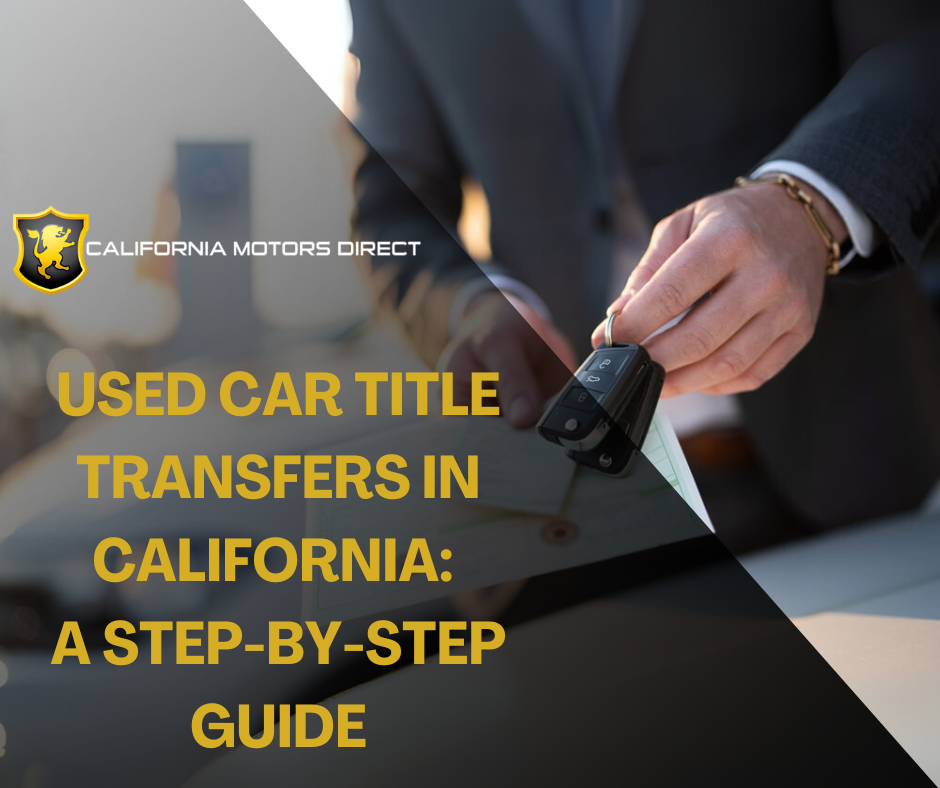
Transferring a used car title in California is more than a formality—it’s a legal requirement that safeguards both the buyer and seller. Whether you’re purchasing a vehicle from a private seller, inheriting one from a family member, or gifting it to a loved one, understanding the title transfer process is crucial to avoid fines, delays, or legal issues.
📄 WHAT IS A VEHICLE TITLE?
A vehicle title, commonly known as a “pink slip,” is a legal certificate of ownership issued by the California Department of Motor Vehicles (DMV). It includes critical details like:
- Registered owner’s name and address
- Vehicle Identification Number (VIN)
- Vehicle year, make, and model
- Odometer reading at the time of transfer (when required)
- Any existing lienholders (e.g., banks or lenders)
- Any title branding (e.g., salvage, rebuilt)
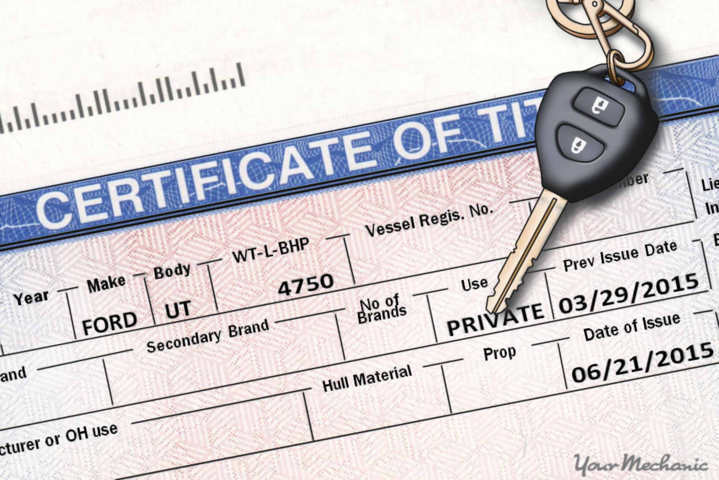
Why is this so important? Because in the eyes of the DMV and California law, if your name isn’t on the title, you don’t legally own the vehicle—even if you’ve paid for it in full.
If you’re a seller, failing to properly transfer the title can leave you liable for tickets, toll violations, or even criminal incidents involving the car after the sale. If you’re a buyer, not securing the title means you can’t register or legally operate the car in your name.
WHEN IS A TITLE TRANSFER REQUIRED?
In California, any change in ownership must be documented with a title transfer, and it must be done within a tight timeframe. The following situations all require a title transfer through the DMV:
- Purchasing or selling a used vehicle
- Gifting a vehicle to a relative or friend
- Donating a vehicle to a nonprofit or charity
- Inheriting a vehicle after the owner’s death
- Paying off a car loan (removing the lienholder)
- Transferring ownership between spouses or domestic partners
⚠️ Important: California gives buyers 10 calendar days to complete the transfer after the purchase. The seller must submit a Notice of Transfer and Release of Liability (NRL) within 5 days of the sale.
TITLE TRANSFER PROCESS IN A PRIVATE SALE
Private sales are incredibly common in California, especially through platforms like Craigslist, Facebook Marketplace, or OfferUp. But they can also be the most error-prone if you don’t understand what’s required.
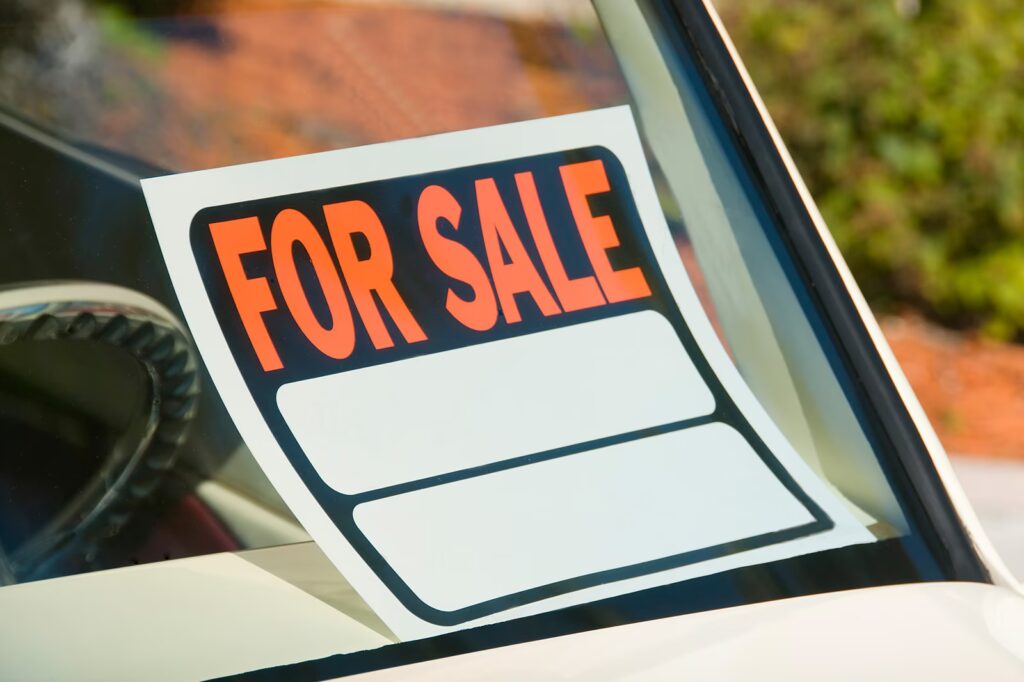
Step 1: Review the Title
The seller must provide a valid, original California Certificate of Title. It should show no lienholders or indicate that any existing lien has been paid off. If the title is lost, the seller must file a Duplicate Title (REG 227) before proceeding.
Step 2: Fill Out the Title
The seller must fill out the “Transfer of Title” section, which includes:
- Buyer’s full legal name and address
- Odometer reading at the time of sale (required if vehicle is under 10 years old)
- Date of sale
- Signatures from both the buyer and seller
Be meticulous—any strike-throughs or smudges may invalidate the document.
⚠️ Tampering with the odometer reading or skipping this step may result in criminal penalties under federal and California law.
Step 3: File a Bill of Sale (Optional but Recommended)
While not legally required, a Bill of Sale (Form REG 135) protects both parties. It documents the agreed-upon sale price, date, and vehicle details. If a dispute arises later, this is your proof.
Step 4: Seller Submits the Notice of Transfer and Release of Liability
The seller must notify the DMV of the ownership change by submitting Form REG 138 within 5 calendar days of the sale. This protects the seller from future liability (tolls, tickets, accidents).
Step 5: Smog Check Requirements

In most private sales, the seller is responsible for providing a current smog certification if the vehicle is more than four model years old.
- Smog tests are valid for 90 days
- Exemptions include electric vehicles, hybrids (in some cases), and diesel-powered cars under specific conditions.
💡 Fact Check: See Smog Information – DMV for current test exemptions and requirements.
Step 6: Buyer Submits Paperwork and Pays Fees
The buyer must visit a DMV office or use an authorized provider to submit:
- The signed title
- Completed Application for Title or Registration (REG 343)
- A valid smog certificate (if applicable)
- Proof of insurance
- Payment for title transfer fee, registration, and use tax
This should be done within 10 days of the purchase. If the car isn’t currently registered, it may need a temporary operating permit while everything is processed.
MORE: Check for Any Damages Before Buying From Private Sales
TITLE TRANSFER FEES AND TAXES IN CALIFORNIA
Title transfers in California aren’t free, but they’re relatively inexpensive—unless you miss a deadline.
Base Fees (as of 2025):
- Title Transfer Fee: $15
- Use Tax: Varies by county and vehicle value
- Smog Transfer Fee (if not already paid): Around $50
- Duplicate Title (if needed): $23
- Late Penalties: Start at $25 and can climb significantly
Remember, even gifts or family transfers may still be subject to a use tax unless properly documented. Always ask for itemized receipts or confirmations of payment for your records.
💡 You can use the DMV Fee Calculator to helps determine the total registration and transfer costs.
DEALERSHIP SALES – WHAT HAPPENS DIFFERENTLY?
If purchasing from a licensed California dealership, things are a bit easier for the buyer. The dealer is required by law to process the title transfer and registration on the buyer’s behalf.
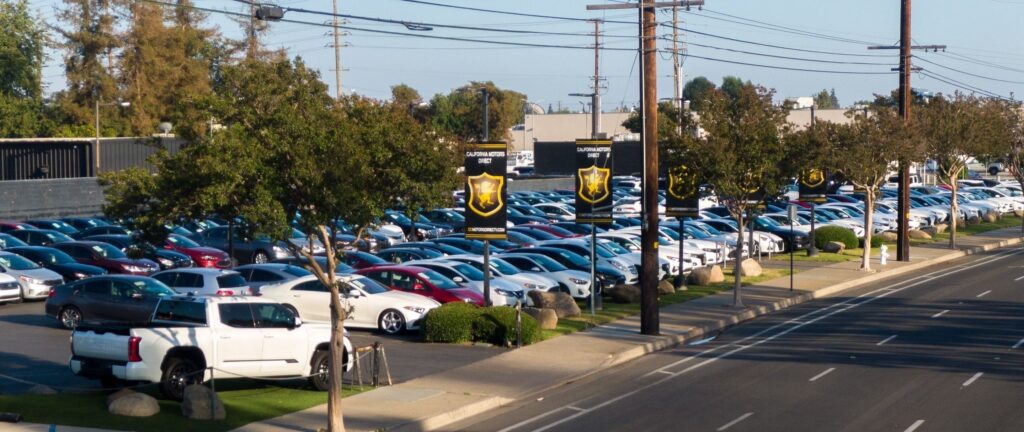
This means:
- Paperwork and submission of all documents to the DMV.
- New registration and title will be mailed directly to the buyer.
- Smog and inspections are handled in-house.
- Sales tax is collected and remitted by the dealer.
That said, don’t assume everything will be perfect. Always double-check that the name and address on the title application is correct, and ask for a copy of all documents submitted to the DMV. Dealership errors, while rare, can delay the registration for weeks or months.
MORE: Get Pre-Approved Today
SPECIAL CASES TITLE TRANSFER
👨👩👧 Family Transfers
Transferring a car between close family members (spouse, domestic partner, parent, child, grandparent, or grandchild) often qualifies for a use tax exemption. You’ll still need to submit the proper forms (REG 343 + REG 256 Statement of Facts), and a smog check may still be required unless an exemption applies.
🎁 Gifts
If giving or receiving a car as a gift (no money exchanged), fill out the REG 343 + REG 256 form to declare the gift status. This helps exempt from the use tax, but are still subject to other registration and title fees.
📜 Inheritance Transfers
Vehicles transferred due to death can usually be done without probate if the estate is small. You’ll need:
- A death certificate
- REG 5 (Affidavit for Transfer Without Probate)
- Proof of your relationship to the deceased
In most cases, the smog certification requirement is waived.
For larger estates, you may need court documents and a transfer through the estate executor.
FREQUENTLY OVERLOOKED (BUT CRITICAL) DETAILS
Many Californians overlook key aspects of the title transfer process—resulting in denied applications, fines, or legal risks. Here are a few things that absolutely should not be ignore:
- Verify the VIN on the title, dashboard, and registration card. They must match exactly.
- Double-check odometer accuracy, especially if the vehicle is under 10 years old.
- Do not buy a car without a title—even if the seller promises to “mail it later.”
- Never sign a blank title as a buyer. That opens the door for title washing or fraud.
- If you’re dealing with a salvage or rebuilt title, make sure you understand the insurance limitations and resale challenges.
MORE: What to Know When Buying a Used Car
SUBMITTING YOUR DOCUMENTS – WHERE AND HOW?
California offers multiple ways to submit your paperwork, depending on your preference and situation:
- In-Person at DMV Offices – Schedule an appointment online at dmv.ca.gov for faster service.
- DMV Business Partners (like AAA) – Often quicker, with shorter lines, but not all services are available.
- By mail or through the DMV Online Portal
Just remember: mail-in processing can take 4 to 6 weeks, so if in a hurry, opt for in-person or third-party services.
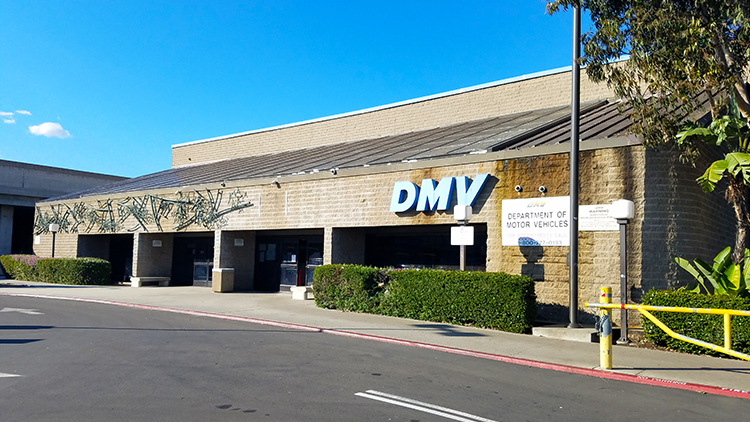
FINAL THOUGHTS:
California’s title transfer process may seem like a hassle, but it’s your legal shield against fraud, liability, and ownership disputes. If done right, it’s seamless. If done wrong, it can cost you time, money, and in some cases—legal trouble.
Take your time. Ask questions. And never assume someone else has “handled it.” When it comes to car titles, what’s on paper is what the DMV believes.
FREQUENTLY ASKED QUESTIONS:
Can I buy or sell a car without a title?
No. California law requires a valid title to legally transfer ownership. If the title is lost, the seller must request a duplicate before the sale.
Can I transfer a vehicle if I still owe money on it?
Only if the lienholder releases interest in writing. The DMV won’t transfer the title until the loan is paid off.
Is notarization required?
No. California does not require notarization for private party title transfers.
How do I check if the title is clean or salvaged before buying?
You can request a Vehicle History Report from services like Carfax or AutoCheck. Alternatively, visit the DMV’s Vehicle Registration Status page and enter the VIN to verify title status.



